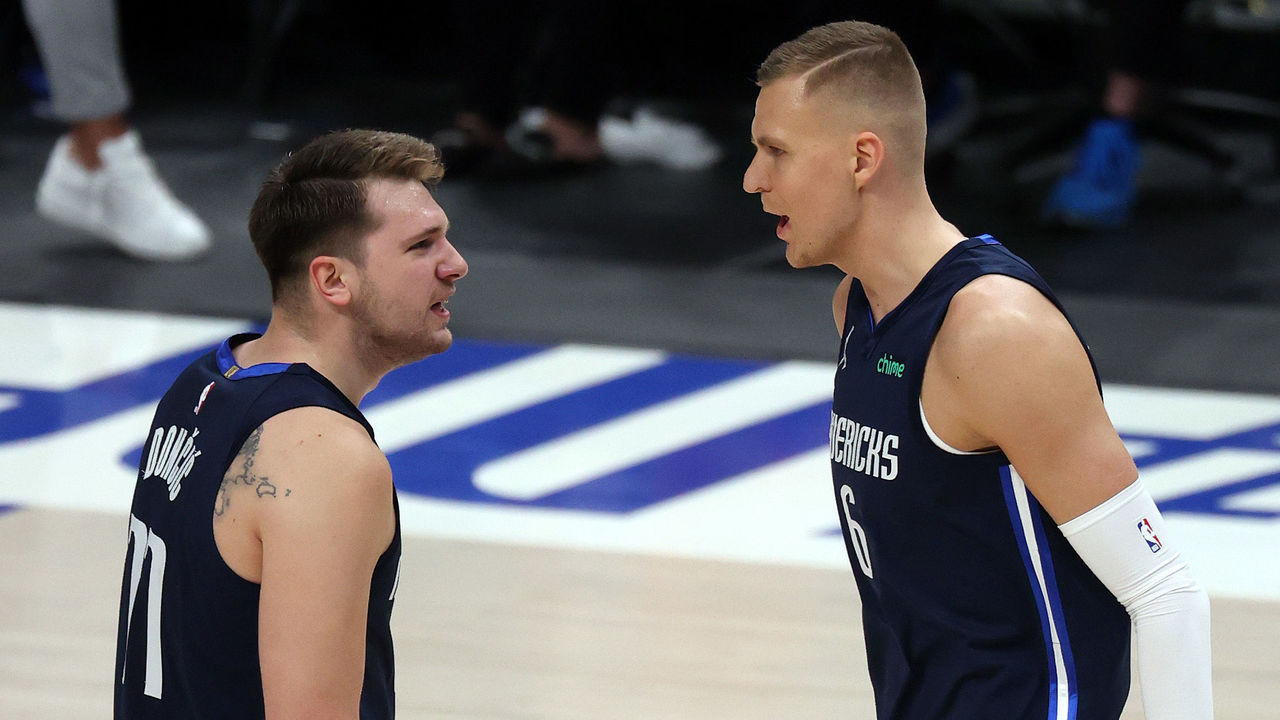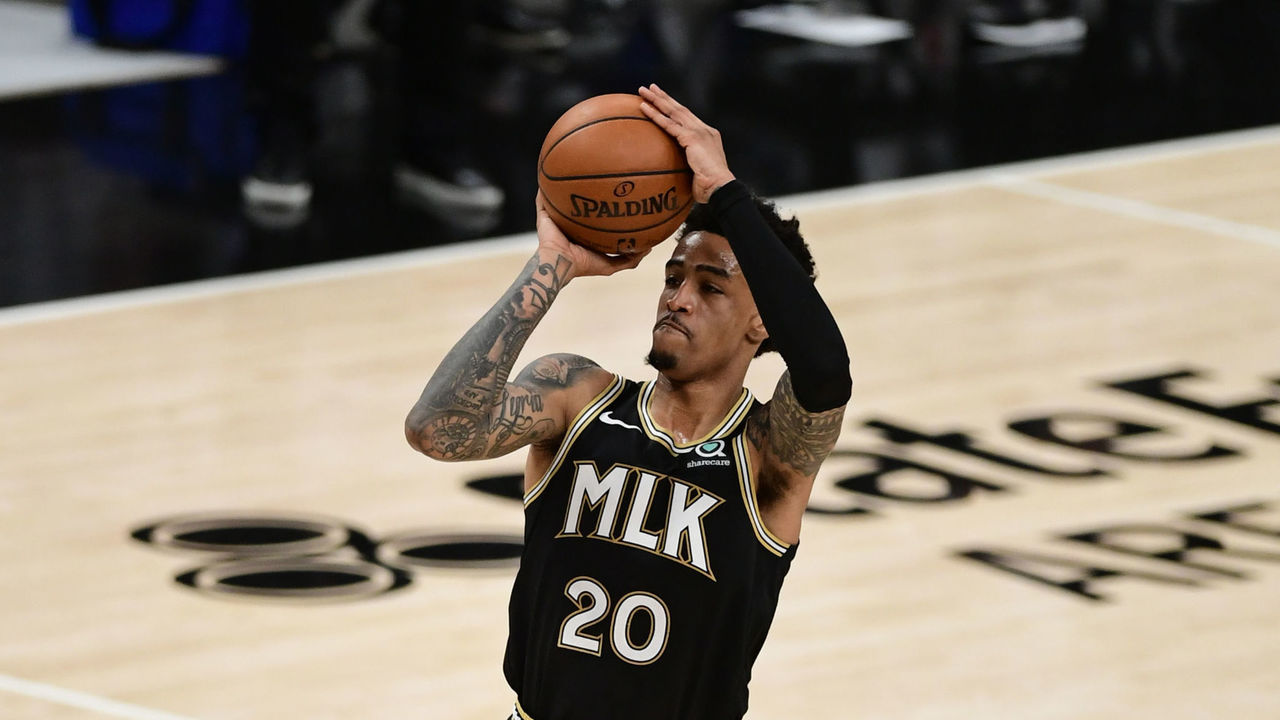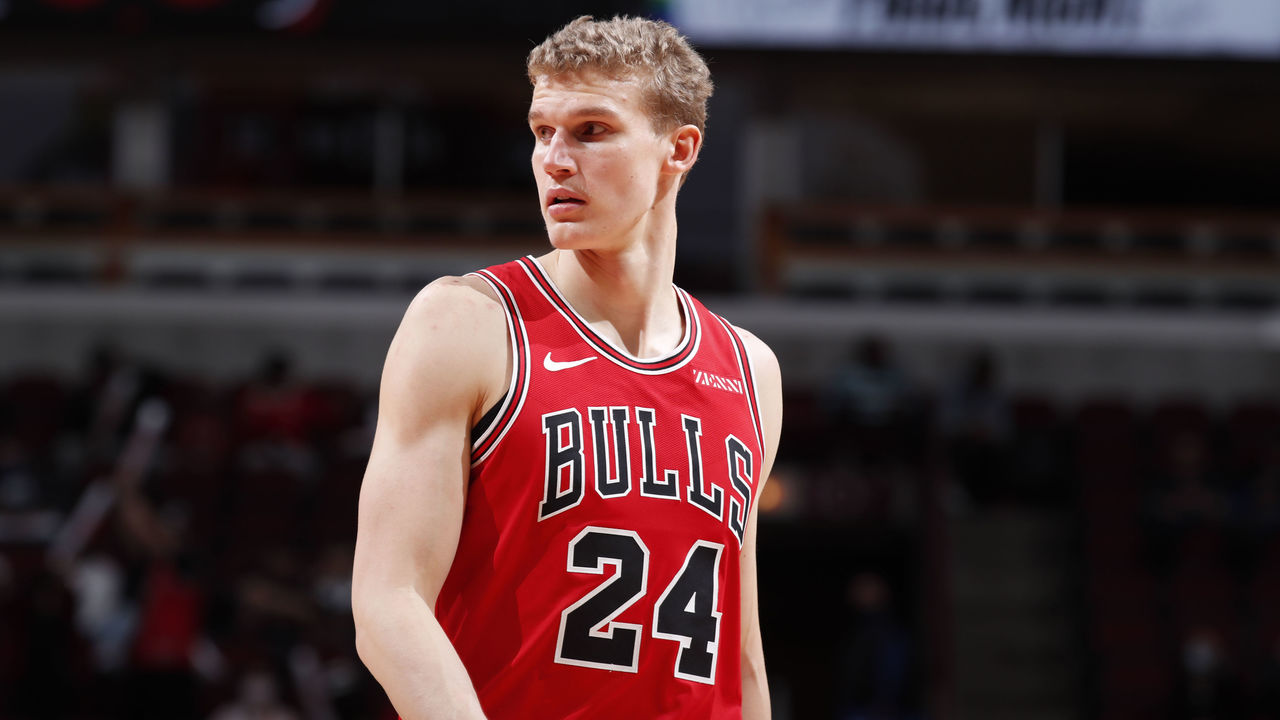Finding the right role for the tweener stretch big
There are players who get labeled as "tweeners" because they’re either positionally flexible or positionally ambiguous. It's the difference between being able to slide seamlessly across multiple positions and being stuck in no man's land. One type of ambiguous tweener who's become particularly fascinating in the current NBA is the stretch big. A handful of young players who fit that mold have been figures of interest this offseason, and another one may be the hinge on which a contender's status will swing.
John Collins secured a five-year, $125-million contract from the Hawks in restricted free agency, while fellow RFA Lauri Markkanen is still languishing without an offer sheet or seemingly any interest from the Bulls. Jaren Jackson Jr. is eligible for an extension from the Grizzlies, but it doesn't appear as though much progress has been made between him and the team. And over in Dallas, Kristaps Porzingis simultaneously feels like the gateway and the impediment to the Mavericks' title-contending aspirations. We're grouping four pretty distinct players under a broad umbrella, but the overarching traits those players share create the outline of an archetype.
Generally speaking, tweener bigs are best suited to play center offensively but have limitations as defenders and/or rebounders that make it untenable to play them at the five consistently. And because the vast majority of traditional rim-protecting centers don't space the floor, it's difficult for stretch bigs to do anything but space when they play next to one. Rim-running falls by the wayside; pick-and-rolls are replaced either by pick-and-pops or by spot-ups that open the lane for someone else to roll; double ball screens can involve both bigs (one popper, one roller), but in a lot of cases the big who can't shoot winds up being featured more in the central action than the one who can.
Porzingis, Collins, Jackson, and Markkanen are hugely talented players who are atypically coordinated for their size and excel at arguably the most important facet of today's game. They shot 37.6%, 39.9%, 39.4%, and 40.2% on a high volume of 3-point attempts, respectively, in their most recent full seasons (2019-20 in Jackson's case, since he missed almost all of last season with a torn meniscus). Yet they've struggled to find their ideal role in spite of (and perhaps partly because of) that one crucial skill. They can find themselves boxed into spot-up roles simply because they represent greater catch-and-shoot threats than the other frontcourt players who play alongside them. It doesn't help that none of them are great face-up players, or that they're all limited as playmakers.
This isn't a problem in and of itself, but it can create issues when these guys start getting paid like franchise pillars. The expectations that come with those contracts don't tend to be commensurate with the role this type of player often settles into. The novelty of having a 3-point-bombing big has long since worn off, and in the playoffs when it counts, switch-heavy schemes become more ubiquitous and tend to erase pick-and-pop looks. Tweener bigs who rely heavily on outside shooting and can't routinely exploit size mismatches are liable to get neutralized in the postseason.

The scrutiny surrounding Porzingis is a good case in point. Though he stands at 7-foot-3, he was largely ineffective as a center last year. When he was the lone big man on the floor, Dallas got outscored by 3.5 points per 100 possessions, recovered just 71.5% of available defensive rebounds (equivalent to the league's third-worst mark), and bled points to the tune of a 118 defensive rating, per NBA Advanced Stats.
The Mavericks have steered him away from typical big-man duties and instead taken to stationing him several feet behind the arc, often solely to pose the threat of a 3-ball. His value (theoretically, at least) lies in his ability to protect the rim at one end while drawing opponents away from it at the other. His role has narrowed over time, in a way that's made him more like a glorified Myles Turner (minus the all-world rim protection) than the unicorn he was once heralded as.
To be clear, that role is as much a product of Porzingis' struggles inside the arc (some of which he improved upon last season) as it is his proficiency beyond it. While his combination of height and skill should make him a dangerous interior presence and multi-level scorer, most other aspects of his game have stagnated as he and the Mavs have leaned into his existing strengths. The winnowing of offensive responsibilities can beget one-dimensionality.
It's easy to roll our eyes at curmudgeons who insist Porzingis needs to get on the block and look to do more damage down low, a critique that ignores his poor body of work as a post player and all-around interior scorer. But it would undoubtedly be helpful if Porzingis could post up and score inside effectively since that would make opponents think twice about sticking wing-sized players on him or switching his pick-and-roll actions. Perhaps he'd have made more progress in those areas if the Mavericks hadn't been so focused on mining his magnetism on the perimeter. But given the caliber of player they're catering to in Luka Doncic, it's hard to quibble with their approach.
The two may not fully mesh on or off the court, but Doncic very much depends on the spacing Porzingis provides. Consider the Mavs' first-round series against the Clippers, when L.A. frequently had Kawhi Leonard guard Porzingis so the Clippers could switch Doncic-Porzingis pick-and-rolls. Dallas responded by simply letting Porzingis hang out on the perimeter to take Leonard away from the central action, while Doncic used alternate screeners and avoided the best defender on the floor. Despite Porzingis' individual struggles in that series (during which he registered a paltry 16.5% usage rate), Dallas scored 18.7 more points per 100 possessions with him on the floor than with him on the bench.
Still, Porzingis is a max player who's been billed as Doncic's co-star, so naturally it became a great source of angst in Dallas when he was relegated to playing the role of a rich man's JaMychal Green in the team's second straight first-round loss. The front office would surely have no qualms about trading him if it felt like there was a chance of bringing back something of comparable value, but such a market doesn't seem to exist. There are going to be loud questions about how far the Mavs can go with him as their second-best player.

That's not to say the Hawks will run into similar issues now they've thrown the bag at Collins. He's close to the optimized version of this player type, having established himself as a viable defender at the four with the ability to score efficiently in a variety of ways.
Collins didn't come into the league as a stretch big. He was a rim-runner first and foremost with solid leaping ability, excellent hands, and touch around the basket. But he never had the size or defensive instincts to capably play the five, and unlocking the Hawks' full potential meant adding Clint Capela to shore up their rim protection and rebounding. In Basketball-Reference's estimation, Collins went from spending 47% of his time at center in 2019-20 to just 14% in 2020-21.
Collins had already slowly started to migrate out to the perimeter, but the Hawks' big addition in the middle prompted a considerable offensive change from him, as Capela (strictly a lob-catching dive man) became Trae Young's primary pick-and-roll partner. Collins averaged less than half as many possessions per game as a roll man this past season as he did in 2019-20 and saw that number dip even further in the playoffs. He saw a similar decline in his paint touches, elbow touches, and shot attempts at the rim:
| Season | Roll-man possessions | Paint touches | At-rim FGA |
|---|---|---|---|
| 2019-20 | 5.1 | 9.4 | 7.8 |
| 2020-21 | 2.5 | 6.1 | 4.7 |
| 2021 playoffs | 2 | 4.2 | 3.3 |
Courtesy: NBA Advanced Stats
Despite eating into Collins' individual production, that redefined role clearly benefited the Hawks as a team.
That doesn't mean there will always be an inverse correlation between his level of offensive involvement and Atlanta's success. Even in his more peripheral role, Collins found plenty of opportunities to cut, duck in for post seals, and scavenge for put-backs. His post-up frequency and efficiency both increased this season as he spent more time at the four and matched up against smaller players more often. There's room for him to expand his game within the confines of the Hawks' Young-and-Capela-centric attack. Atlanta's long-term investment in him feels like a sound one.
Porzingis feels like a more apt analog (or cautionary tale, if you prefer) for Jackson, right down to the worrisome knee issues. It may seem like heresy to compare the much-maligned Latvian to one of the pearls of the Grizzlies' ahead-of-schedule rebuild, and it's obviously far too early to put any kind of comp or ceiling on the 21-year-old, who moves better, shoots better off of movement, and has a chance to be a significantly more versatile defender than any of the other bigs mentioned herein. But three years into his career, Jackson still doesn't have a clearly defined defensive position and operates more like an off-ball guard than a big man on offense.
That movement shooting, at his size, makes him one of the most unique players in the league and an ideal offensive complement to Ja Morant. Jackson can also be a highly effective roll man and post scorer, but those skills often go untapped because of how regularly he plays next to a lane-clogging center. He certainly has the height to play the five, and would be optimized offensively by doing so. But he hasn't proven capable of rebounding or anchoring the defense at nearly the level required to man the position on a full-time basis.
For all the tantalizing promise of switchy lineups with Jackson's nimble feet at center, the Grizzlies were consistently much better defensively when he shared the floor with Jonas Valanciunas than when he went solo up front. Of course, Valanciunas is gone now, and trading him may have been an indication that Memphis is prepared to lean further into lineups with Jackson at center. But the uncertainty over what those lineups might look like, coupled with Jackson's limitations as a ball-in-hand offensive player, may be part of the reason (likely secondary to his health) why the Grizzlies are wary of handing him a max extension.

Markkanen is the most limited of these players, with basically no track record of contributing to winning basketball. That doesn't make him a lost cause. This past season was the first one in which he really lived up to his theoretical billing as a marksman, hitting over 40% on nearly six 3-point attempts per game. There were other promising signs, too, like a refined touch around the rim that resulted in a career-best 58.2% mark from 2-point range.
Alas, that shooting improvement didn't prevent the Bulls from getting handily outscored with him on the floor, probably because Markkanen remains a non-playmaker with a limited post game, lateral-quickness issues, and no defensive rim presence to speak of. His 20.2% usage rate was the lowest mark of his career. He was admittedly in a tough spot last season in a crowded frontcourt that forced him to play spot minutes at small forward after the trade deadline. (Those jumbo lineups were also sneakily effective on defense.) Whatever his other limitations, a guy who can give you 62% true shooting on medium volume is nothing to sneeze at.
Regardless, the Bulls seem prepared to sneeze at Markkanen and move on, and no other team seems especially eager to sign him. Given the extent to which cap space has dried up around the league, it will be a surprise if he winds up inking a deal for more than the mid-level exception. It frankly won't be a shock if he takes the qualifying offer from Chicago and re-enters the market as a UFA next summer.
Obviously, these players can and should continue trying to round out their games, but unless they develop elite face-up or post-up or playmaking chops, or learn to thrive playing center, medium-usage perimeter roles will likely remain the best application of their skill sets in this day and age. Heck, even Hall of Fame-caliber big men like Chris Bosh and Kevin Love ultimately had to make that type of shift in order to get the most out of their LeBron-led teams.
The supplemental skills those guys brought (defense from Bosh, rebounding and post scoring from Love) were still critical, though, and that's true of all the players covered here, too. We're using a blanket term to lump them together, but there's a wide spectrum of skill and utility within this category. Perhaps players like Jackson and Collins can even transcend the paradigm and become legitimate franchise players.
Either way, this feels like a minor inflection point for the tweener stretch big, and it will be interesting to monitor how this archetype - and the league's understanding and valuation of it - evolves over time.